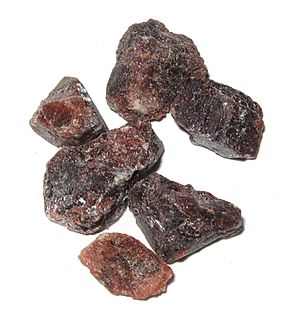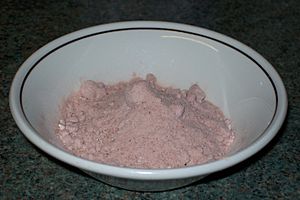Kala namak facts for kids

Large pieces of Kala Namak
|
|
| Alternative names | Kala Namak |
|---|---|
| Region or state | South Asia, Himalayan regions |
Kala namak is a special type of rock salt that has been heated in a hot oven. It has a unique, strong smell, a bit like sulfur or cooked eggs. People in the Indian subcontinent (countries like India, Pakistan, and Bangladesh) use it a lot.
This salt is also known by many other names, such as "Himalayan black salt" or Sulemani namak. It comes from salt mines near the Himalayas mountains.
Kala namak is mostly made of regular sodium chloride. But it also has other things that give it its special color and smell. The strong smell comes mainly from sulfur. Because of a mineral called Greigite inside it, whole pieces of kala namak look brownish-pink to dark purple. When it's ground into a powder, it turns purple or pink.
People who follow Ayurveda, an ancient Indian system of medicine, have valued kala namak for its believed health benefits.
Contents
How Kala Namak is Made
The salt used to make Kala Namak originally came from natural salt deposits. These were found in mines in Northern India and in salt lakes like Sambhar Salt Lake.
Traditional Production Method
Traditionally, plain salt was turned into the dark Kala Namak using a special heating process. This process changes some of the natural chemicals in the salt into smelly ones like hydrogen sulfide.
Here's how it worked:
- Raw salt was sealed in a ceramic pot.
- Charcoal was added, along with small amounts of certain plant seeds or bark.
- The pot was heated in a very hot oven, called a kiln, for 24 hours.
- During heating, the salt melted, and chemical reactions happened.
- After cooling, the salt was stored and aged before being sold.
This method is still used in parts of northern India, especially in the Hisar district of Haryana. The salt crystals look black, but when ground, they become a fine purple powder.
Modern Production Methods
Today, it's common to add the necessary chemicals directly to pure salt before heating it. This makes the process simpler. You can also make similar salts by heating regular salt with small amounts of sodium carbonate, sodium sulfate, and some sugar.
What Kala Namak is Made Of
Kala namak is mainly sodium chloride. It also has tiny amounts of other chemicals like sodium sulfate, sodium bisulfate, and iron sulfide.
- The sodium chloride gives it its salty taste.
- Iron sulfide gives it its dark purple color.
- All the sulfur compounds give kala namak its unique savory taste and strong smell. Hydrogen sulfide is the main reason for its distinct smell.
- The acidic bisulfates give it a slightly sour taste.
Even though hydrogen sulfide can be harmful in large amounts, the amount in kala namak used in food is very small. So, it's safe to eat. Interestingly, hydrogen sulfide is also found in small amounts in the smell of cooked eggs!
How Kala Namak is Used
Kala namak is a very popular ingredient in South Asian cooking. People in India, Pakistan, Bangladesh, and Nepal use it in many ways:
- As a seasoning on its own.
- Added to chaats (savory snacks), chutneys, salads, and fruit.
- Mixed into raitas (yogurt dishes).
It's a key ingredient in Chaat masala, a famous Indian spice mix. Black salt gives Chaat masala its special egg-like smell. Some people who aren't used to it might find the smell unusual. In North India and Pakistan, a little black salt is often sprinkled on fruits or snacks.
Vegan cooks sometimes use Kala Namak to give tofu dishes an "egg" flavor, especially in plant-based egg recipes.
Traditional Health Uses
In Ayurveda, kala namak is thought to be a "cooling" spice. It has been traditionally used to help with digestion and to relieve flatulence (gas) and heartburn. In Jammu, it was even used to treat goitres (swelling in the neck). It was also mixed with other natural ingredients to make toothpastes. However, some of these traditional health claims are not scientifically proven.
See also
 In Spanish: Sal negra para niños
In Spanish: Sal negra para niños


